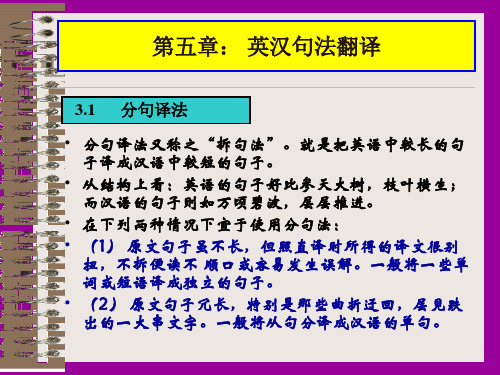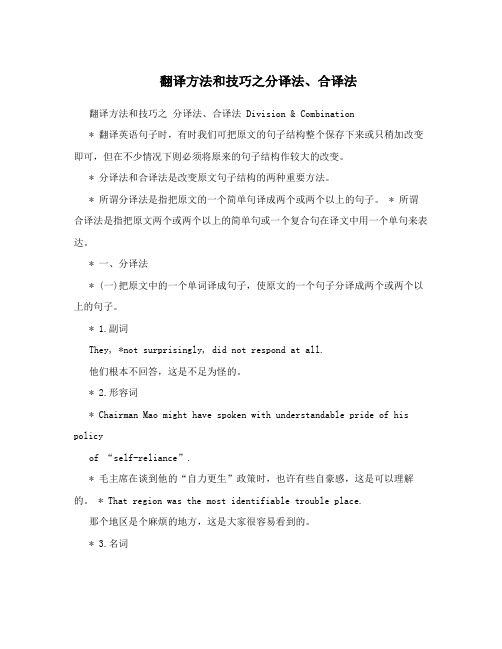翻译第十讲(分句合句&定语从句译法)
英语翻译10分句法合句法ppt课件

1) He had to quit the position and went into exile, having been deprived of his power.
他被剥夺了权利之后,他只好辞职,
流落他乡。
2) The child gave a cry and with outstretched arms ran forward.
她的儿子非常聪明,可女儿却很笨。
4) He suffered aches and pains. 他遭受百般疼痛。
5) He is a man of culture and learning.
他是个很有学问的人。
6) I hate all these hustle and bustle. 我讨厌这种拥挤不堪的场面。
八月中旬,维修人员在烈日下工作。
Exercises
He visited many places, in all of which he was received with the usual enthusiasm which attended his arduous labors.
伟大的中华人民共和国必须用我们大家的 鲜血和工作来缔造。我们这些人相信未来, 相信人们,相信人们能够掌握自己的命 运—---- 光辉灿烂的命运。
合句法:
1. 词的合译
1) You will supply financial power, and we’ll supply man power. Isn’t that fair and square?
那孩子叫了一声,伸开两臂,跑了过 去。
3) Being summer, the rivers were open and navigable.
英汉句法翻译(分句、合句与长句)

3.1 分句译法
• 分句译法又称之“拆句法”。就是把英语中较长的句 子译成汉语中较短的句子。
• 从结构上看:英语的句子好比参天大树,枝叶横生; 而汉语的句子则如万顷碧波,层层推进。
• 在下列两种情况下宜于使用分句法: • (1) 原文句子虽不长,但照直译时所得的译文很别
扭,不拆便读不 顺口或容易发生误解。一般将一些单 词或短语译成独立的句子。 • (2) 原文句子冗长,特别是那些曲折迂回,层见跌 出的一大串文字。一般将从句分译成汉语的单句。
• 4. He shook his head and his eyes were wide, then narrowed in indignation.
• 他摇了摇头,两目睁得圆圆的,接着又眯成一条线,脸 上露出了愤怒的神色。
3.1.2 将词组或短语译成汉语的句子
• 1.I wrote four books in the first three years, a record never touched before.
• 由于受到顽强抵抗,吹嘘能在几个小时内就占领要地的敌人甚 至还没有能占领外围地带,这一事实使我增强了信心。
指代它,与主句的其他 成分连句成文。
got to know the real people of Egypt.
• 英国人在埃及呆了那么多
年,却从来没有真正了解
埃及人,这是异乎寻常的。
4. It’s quite probable that he is gone.(他已经走了,有那一是条很举可世能的公。)
3.3.1 切断法(顺序法)
• 所谓切断法,就是按英语句子的语序把英语长句“化整为零”, 按意群将长句断开译成若干汉语分句。如:
定语从句的译法概要

• 谁如果只守城堡而不往远处看,那他就是一个目光短 浅的指挥员。
•
练习:
•
1.This is the soldier who just returned from the front.
• 一、限制性定语从句 • 前置、后置、融合法 • 二、非限制性定语从句 • 前置、后置、译成独立句法 • 三、兼有状语功能的定从 • 译成相应的偏正复句
Key and Difficult Points
• 1.后置、融合法 • 2.译成独立句法 • 3.兼有状语功能的定从
Teaching Contents
• 第一次世界打颤战是帝国主义列强之间争夺市场、资源和 领土的冲突,而第二次世界大战却比第一次复杂。
译成独立句
• 与主干分开,译成一个独立的汉语句子。
• She is reading a novel, the name of which I don’t know.
• 她在看一本小说。书名我不知道。
• He had talked to the Vice-President, who assured him that everything that could be done would be done.
• 他和副总统谈过话。副总统向他担保,凡是能够 做到的都将竭尽全力去做。
三、兼有状语职能的定语从句
• C. 在译文中从句前置,重复英语关系词所代表的含义
• World War II was ,however, more complex than World War I, which was a collision among the imperialist powers over the spoils of markets, resources and territories.
英汉翻译的基本技(9)-分句与合句

• Energy can neither be created nor destroyed, a universally accepted law.
• 能量既不能被创造也不能被消灭,这是一 条普遍公认的规律。
(二)、短语分译
• Invitingly green Angel Island, once a military installation, contains meandering trails and picnic spots ideal for a day’s excursion.
• 长期以来,他的同僚虽然看不起他,却还 是对他有些亲切感;现在,除• At present people have a tendency to
choose the safety of the middle-ground reply. • 现在,人们都倾向于采取不偏不倚的态度 来回答问题,因为它安全,不招风险。
一、分句法
• 分句就是常用的一种方法,它常包括:
• (一)、单词分译 • (二)、短语分译 • (三)、句子分译
(一)、单词分译
• 单词分译是指把原文中的一个单词拆译成 一个句子,使原文中的一个句子分译成两 个或两个以上的句子。
• 采用单词分译主要有两个目的:一是为了 句法上的需要。由于一些单词在搭配、词 义等方面的特点,直译会使句子生硬晦涩, 翻译腔十足,而把某个单词分译却能使句 子通顺,且不损伤原意。二是为了修饰上 的需要,如加强语气,突出重点等。
合适。
(二)、短语分译
• During several hours of semiconscious sleep, Lydia dreamed of Jean-Jacques, feeling his presence.
论英语翻译基本技巧中的分句与合句

论英语翻译基本技巧中的分句与合句论英语翻译基本技巧中的分句与合句翻阅了《新编英汉翻译教程》之后,我对其中第六章翻译的基本技巧的第五个知识点分句与合句很感兴趣,因此决定详细的探究这个部分。
分译与合译是科普书籍英译汉翻译实践中两种常用的方法,具有化整为零和化零为整的效果。
分译可以将英语中结构和内容杂糅的成分分而治之,化繁为简,使译文更具可读性和简约性;合译可以将英语中结构和内容零散的成分统筹规划,同样可以化繁为简,使译文更具整体性和连贯性.翻译英语句子时,有时我们可把原文的句于结构整个保留下来或只稍加改变,但不少情况下则必须将原来的句子结构作较大的改变。
如果囿于原文,把每一个英语句子都译成一个汉语句子,一个萝卜一个坑,就会出现译文的句子臃肿或层次不清。
由于英汉两种语言在造句方法和修辞手段等方面的差异,有时需要把一个英语复句译成一个或一个以上汉语单句,有时又需要把两个或两个以上英语单句译成一个汉语句子。
我们把前一种方法称为分译,把后一种方法称为合译。
分译和合译是改变原文结构的两种重要方法。
分译与合译的目的是为了更好地表达原文的意思,使译文更合乎汉语的习惯。
由于英语句子结构复杂,常常是主语带从句,从句中又套有从句,睇相叠加,因此,英语中多见长句。
这是英语句子的主要特点之一。
由于在句子表达上英语以长句见长,而汉语以短句为特色,因此,翻译时我们必须注意两种语言句子表达的不同特点,适当的调整译文句子长度以符合译入语的句法要求和表达习惯。
通常来说,表达内容相同时,韩语句子在数量上比英语多,因此在英汉翻译时,英语的一个长句往往需要转译为汉语的几个短句。
在英汉翻译中,我们常会遇到将两个或数个英语句子合译为一个汉语单句的情况。
例如:英语:She is very busy at home. She has to take care of the children and do the housework.汉译:她在家里忙得不可开交,既要照顾孩子,又要做家务。
翻译方法和技巧之分译法、合译法

翻译方法和技巧之分译法、合译法翻译方法和技巧之分译法、合译法 Division & Combination* 翻译英语句子时,有时我们可把原文的句子结构整个保存下来或只稍加改变即可,但在不少情况下则必须将原来的句子结构作较大的改变。
* 分译法和合译法是改变原文句子结构的两种重要方法。
* 所谓分译法是指把原文的一个简单句译成两个或两个以上的句子。
* 所谓合译法是指把原文两个或两个以上的简单句或一个复合句在译文中用一个单句来表达。
* 一、分译法* (一)把原文中的一个单词译成句子,使原文的一个句子分译成两个或两个以上的句子。
* 1.副词They, *not surprisingly, did not respond at all.他们根本不回答,这是不足为怪的。
* 2.形容词* Chairman Mao might have spoken with understandable pride of his policyof “self-reliance”.* 毛主席在谈到他的“自力更生”政策时,也许有些自豪感,这是可以理解的。
* That region was the most identifiable trouble place.那个地区是个麻烦的地方,这是大家很容易看到的。
* 3.名词* A movie of me leaving that place would look like a shell leaving a rifle.* 我离开那个地方的速度之快,要是拍成电影的话,会像出膛的子弹一样。
* He shook his head and his eyes were wide, then narrowed in indignation.他摇了摇头,双目瞪地圆圆的。
* (二)把原文中的一个短语译成句子,使原文的一个句子分译成两个或两个以上的句子。
* 1.分词短语* She sat with her hands cupping her chin, staring at a corner ofthe littlekitchen.* 她坐在那儿双手托着下巴,眼睛凝视着小厨房的一角。
英汉句法翻译(分句合句与长句)课件

随着全球化的加速和跨文化交流的增加,英汉句 法翻译的需求将进一步增加,推动翻译行业的不 断发展。
翻译标准的完善
随着翻译实践的深入和理论研究的丰富,英汉句 法翻译的标准和规范将不断完善,提高翻译的质 量和水平。
THANK YOU
感谢各位观看
分句的翻译技巧
01
02
03
直译与意译
根据分句的具体含义和语 境,选择合适的翻译方法 ,直译保留原文形式,意 译注重原文意思的传达。
增译与减译
根据中文表达习惯,对分 句进行适当的增译或减译 ,增补必要的成分,删除 冗余部分。
语态转换
注意英汉两种语言的语态 差异,正确处理分句中的 被动语态,转换为中文的 主动语态或被动语态。
表达不自然
在翻译长句时,可能会因为追求形式上的对等而忽略了语 言的自然流畅。解决方案是注重译文的自然表达,适当调 整语序和结构,使译文更加通顺易懂。
05
英汉句法翻译实践
常见分句合句与长句的翻译实例
分句合句技巧
将英语中的长句拆分成几个短句,再根据中文的表达习惯重 新组合,使译文更加流畅自然。例如,将“He not only finished his homework, but also cleaned the room.”拆 分为“他不仅完成了作业,还打扫了房间。”
英汉句法翻译(分句合句与长句) 课件
目录
• 英汉句法对比 • 英汉分句翻译 • 英汉合句翻译 • 英汉长句翻译 • 英汉句法翻译实践
01
英汉句法对比
句子结构对比
01
英语句子结构以主语+谓语为核 心,强调形式上的主谓一致和完 整的句子结构。
02
汉语句子结构则更加灵活,主语 和谓语之间不一定有严格的一致 性,且常使用无主语句。
翻译技巧——分与合

翻译技巧——分与合一、分译分译就是根据行文需要,将一句译为几句。
亦称化整为零法。
(一)、将原文中的某一部分抽出来,单独译成一句。
1.The year 1983 began----and ended----with an unusual oil crisis: fears that the price of crude oil would notgo up but down.1983年新年伊始,就存在着一种异乎寻常的石油危机:人们担心原油价格要下降,而不是上扬。
这一年结束的时候,情况依然如故。
2.This exquisite harmony between nature and Man explains in part the enchantment (心醉,乐趣;诱惑) of theolder Britain, in which whole towns fitted snugly(温暖而舒适的;紧贴的)into the landscape, as if they were no more than bits of woodland.自然和人之间的无比和谐正是英国从前部分魅力所在。
当时的英国,整个城镇就像片片树林一样,巧妙地融入风景画中。
3.The popular reaction to the debt problem particularly in the United States, was try to punish the banks forhaving lent money to developing countries rather than to neighborhood companies.一般人对债务问题的反应是试图惩罚这些银行,责怪它们把钱借给了发展中国家,而不是借给本地的公司。
在美国,情况尤其如此。
(二)、将较长的一句分译为数句。
1.Her boyfriend has recently returned home from Long Island and he told her of the house where he wasboarded, and lodged, a red-tiled(瓷砖)bungalow, on a little hill, overlooking the blue sea, with a large, shady garden behind it.她的男友刚从长岛回国不久。
【翻译技巧】英语笔译句法——合句译法

【翻译技巧】英语笔译句法——合句译法合句译法(又称:并句译法),从技术上说,是与断句译法相反的操作,即把原文中内容关系密切的两个或多个句子合成一个句子。
严格来说,合句译法和缩句译法都属于一种压缩:合句译法是压缩原文的两个或多个句子,合为一个句子(缩句为句);缩句译法是压缩原文的短句或单句,合为一个句子的组成部分(缩句为词)。
我们知道,英语句子一般都要比汉语句子长,其容量也远比汉语句子大得多。
汉译英时,往往必须先找出隐藏或模糊的主谓结构与框架,树起主干,然后将各种关系词、短语(介词短语、名词短语)、附加成分(同位语、插入语)、分词结构、从句(定语从句、状语从句、同位语从句)等添加到主干,使树木枝繁叶茂,形成所谓的“树式结构”。
翻译汉语的多个分句时,注意分析各个分句之间的逻辑关系,确定好主从关系,并采用恰当的方式进行连接。
因此,合句译法对于汉译英而言意义非凡。
当然,在英译汉时,对于比较口语化的英语短句,我们也可以考虑用合句译法,将其翻译成一个汉语句子。
在使用得当的情况下,合句译法和缩句译法都能有效调整句子长度,使译文词句简练、逻辑关系清晰、语气连贯、一气呵成。
英译汉中的合句译法1、并列关系合句—汉语译句通常以“和”、“并”、“及”、“而”、“且”、“也”、“还”、“同时”、“(既)又(要)…,又(要)…”、“(一)边…(一)边…”等表示并列关系的连接词连接。
He was very clean.//His mind was open.他为人单纯而坦率。
My15students read Emerson,Thoreau and Huxley.//They kept diaries.//They wrote term papers.我教的15名学生读了艾默生、格洛和赫胥黎的作品,记了笔记,还写了学期论文。
He would miss many things and many people.//He would miss Celia.他会想念许多人和往事,也会想念他的西莉亚。
合句与分句

4.译状语从句
例4: Chaplin, whose mother was ill for many years, had to dance in streets to earn money. 译文:由于母亲病了好多年, 译文:由于母亲病了好多年,卓别林不得不到街 头表演去挣钱。(表示原因) 。(表示原因 头表演去挣钱。(表示原因) 例5:But the Southern States wanted to set up a country of their own, where they would be free to keep black slaves. 但是南方各州却想建立他们自己的国家,以便在 但是南方各州却想建立他们自己的国家, 那里他们可以随心所欲地继续把黑人当作奴隶。 那里他们可以随心所欲地继续把黑人当作奴隶。 (表示目的) 表示目的)
C.定语从句中的合句法
He took out a bottle of wine out of his pocket, which he began to drink slowly. 译文:他从衣兜里掏出一瓶酒慢慢地喝起来。 译文:他从衣兜里掏出一瓶酒慢慢地喝起来。 例2: We will send the boy to Britain, where he can receive better education. 译文:我们将要把这个孩子送到英国去接受更 译文: 好的教育。 好的教育。
B. 把原文中的主从复合句(Complex 把原文中的主从复合句( Sentence) Sentence)译成一句
1. If we do a thing, we should do it well. 我们要干就干好。 我们要干就干好。 2. It was in mid-September, and the new midstudents attended the military training under the blazing sun. 九月中旬,新生在骄阳下军训。 九月中旬,新生在骄阳下军训。 3. Home after seven years. Home. The word had meant so much to him. 阔别了七年的家, 家,阔别了七年的家,这个词对他是多么亲切 啊!
英汉翻译分句、合句法

法律文体的翻译
01
法律文体特点
法律文体通常具有权威性和严谨性的 特点,语言规范、正式、庄重,强调 语义的准确性和表述的严谨性。
02
分句法运用
在法律文体的英汉翻译中,分句法常 用于将长句拆分成短句,以突出法律 条款的核心内容和逻辑关系,使译文 更加符合法律文体的规范要求。
03
合句法运用
在法律文体的英汉翻译中,合句法常 用于将多个短句合并成一个长句,以 保留原文的法律术语和表述方式,使 译文更加准确严谨地传达原文的含义 。
详细描述
在英汉翻译中,要注意行文流畅性,避免出 现生硬或过于直译的情况。可以通过调整语 序、增减词汇、改变句式等方式,使译文更 加自然、流畅,符合目标语言的表达习惯。
文化因素
总结词
考虑到文化差异,准确传达原文的文化内涵 。
详细描述
英汉翻译中,要特别注意文化因素的差异。 由于不同文化背景下的语言表达习惯和思维 方式存在差异,因此需要深入了解目标语言 的文化背景,准确传达原文的文化内涵,避 免出现文化误解或冲突。同时,要注意尊重 目标语言的文化习惯和表达方式,使译文更
英汉翻译分句、合句法
contents
目录
• 英汉翻译分句法 • 英汉翻译合句法 • 英汉翻译分句、合句法的运用 • 英汉翻译分句、合句法的注意事项
01 英汉翻译分句法
英语长句的切分
英语长句的切分
在英汉翻译个短句,以便更准确地传达原文意思。
切分依据
切分依据主要包括句子的逻辑关系、语法结构以及语义内容等 。通过合理切分,能够使译文更加流畅、自然,符合中文表达
习惯。
切分技巧
在切分长句时,可以按照主句和从句、主语和谓语、以及意群 等进行划分。同时,需要注意保留句子间的衔接和连贯,避免
汉英翻译实践第十讲(《灰尘的旅行》及中外翻译简史)

I. 原文(Source Text)灰尘的旅行(一)灰尘是地球上永不疲倦的旅行者,它随着空气而飘流,可以说是无孔不入。
我们周围的空间,从室内到室外,从城市到野外,从平原到山区,从沙漠到海洋1,几乎处处都有灰尘的行踪2。
真正没有灰尘的空间,只有在实验室里才能制造出来。
在晴朗的天空下,灰尘是看不见的,只有在太阳的光线射进黑暗的房间的时候,才能够看到无数的灰尘3在空中飘舞。
大的灰尘肉眼可以看见,小的灰尘比细菌还小,用显微镜4也观察不到。
根据检验的结果,在干燥的日子里,田野和高山的空气里,每一立方厘米5只有几十粒灰尘;在海洋上空的空气里,每一立方厘米大约有一千多粒灰尘;在城市街道上的空气里,每一立方厘米大约有十万粒以上的灰尘;在住宅区的空气里,灰尘还要多得多。
这样多的灰尘在空中旅行,对气象变化产生了很大影响。
原来灰尘还是制造云雾和雨点的小工程师,它们会帮助空气中的水分疑结成云雾和雨点。
没有灰尘,就没有白云,也没有大雨和小雨了;没有灰尘,在夏天,强烈的日光将直接照射在大地上,使气温无法降低6。
这是灰尘在自然界中的功用。
如果我们追问一下,灰尘都是从什么地方来的呢? 到底是些什么东西呢? 我们可以得到下面一系列的答案:有的是来自山地岩石的碎末,有的是来自田野的干燥土末,有的是来自海面的由浪花蒸发后生成的食盐粉末,有的是来自火山灰,还有的是来自星际空间的宇宙尘。
这些都是天然的灰尘。
II. 理解难点提示(Suggestions for Comprehension)1. 这几个“从……到……”是说灰尘的运动方向,还是说其存在之地?2. “有灰尘的行踪”是说灰尘本身不存在了,还留下了踪迹吗?3. 前面以“它”指代灰尘,这里为什么又说“无数的灰尘”?4. “用显微镜”的具体方式是什么?5.“田野和高山的空气里,每一立方厘米”是说一立方厘米的什么东西?6. 这两个分句的关系如何?III. 译文(Target Text)The Travels of Dust (1)Dust, a tireless traveler on earth1, floats along with the movement of air and can be said to be all-pervasive2.Dust can be found3almost everywhere in the space around us, indoors and outdoors, over cities and the country, plains and mountains, deserts and the sea4. Space truly without dust can only be created in laboratories.In the sunny sky5 dust is invisible; only when sunlight shines into a dark room can one see numberless dust particles6flying in the air. Bigger particles can be seen by the naked eye, but smaller ones may be smaller than germs7, and cannot be observed even through a microscope8.According to the results of experiments, on dry days there are a few dozen particles of dust in each cubic cm of air over the fields and mountains, more than a thousand over the sea, more than 100,000 in the streets of cities, and much more in residential areas9.So much dust traveling in the air exerts great influence on weather changes. It turns out that10 dust particles are tiny engineers that make clouds and raindrops, helping as they do the moisture to condense into clouds, fog and raindrops. Without them, there would be no white clouds, nor drenchers or drizzles11; without them, the scorching sun12 in summer would shine directly on the earth, making it impossible for the temperature to come down13. That is the function of dust innature.If we ask where all the dust comes from and what on earth it is, we can get the following series of answers: from tiny bits of rock in mountainous regions, from dry earth in the fields, from salt powder formed by evaporated spray on the sea, from volcanic ashes, or14 from meteoroid in outer space. All this is natural dust.IV. 表达解说(Explanation of Expression)1. 汉译英时,如果“A是B,……”中的“是B”重要性不如后续的分句,往往译为同位语,以显示层次。
英语翻译技巧拆句与合句

英语翻译技巧拆句与合句拆句法与合句法这是两种相对应的翻译方法。
接下来,小编给大家准备了英语翻译技巧拆句与合句,欢迎大家参考与借鉴。
英语翻译技巧拆句与合句拆句法,就是把原文一个简单的句子拆译成两个或两个以上的句子。
合句法,就是把原文中两个或两个以上的简单句或一个复合句在译文中用一个句子表达起来。
(一)拆句法具体来说,拆句法可以分为单词拆译、短语拆译和句子拆译三种。
1. 单词拆译单词拆译是把原文中的一个单词拆译成一个句子。
英语中,由于有些单词在搭配及词义等方面的特点,直译会使句子生硬晦涩,而把单词拆译出来能使句子通顺。
另外,有的时候为了加强语气,突出重点,也会使用单词拆译。
如:原文:At present people have a tendency to choose the safety of the middle-ground reply.译文:现在,人们都倾向于采取不偏不倚的态度来回答问题,因为它安全,不招风险。
原文:Chairman Mao might have spoken with understandable pride of his policy of “self-reliance”.译文:毛主席在谈到他的“自力更生”的政策时,也许有些自豪感,这是可以理解的。
原文:Buckly was in a clear minority.译文:巴克利属于少数派,这是明摆着的事实。
原文:Jerry quickly ordered everyone to put on life jackets, and tried unsuccessfully to put out the fire.译文:杰瑞立即叫大家穿上救生衣,并且奋力扑火,但却无济于事。
2. 短语拆译短语拆译是把原文中的一个短语拆译成一个句子。
如:原文:The power increased with their number.译文:他们人数增加了,力量也随之增强。
lecture分句合句译法

pride of the policy of “self-reliance”. ➢ 周总理在谈到“自力更生”政策时,也许有些自豪感,
这是可以理解的。
• 这是一艘几乎装满了卡车和装甲车的坦克登陆 舰。
• The river ran down to Pisa from Florence, and then it reached the sea.
• 那条河从佛罗伦萨流到比萨,然后到达大海。 • 那条河从佛罗伦萨流经比萨入海。
Combination of complex sentences
➢ The number of the young people in the United States who cannot read is incredible—about one in four.
➢ 大约四分之一的美国青年人不会阅读,这简直令人难以 置信!
➢ His theory is an unparalleled great contribution to the science.
• 门口放着一堆雨伞,少说也有十二把,五颜六色,大 小不一。
• 门口放着至少有十二把五颜六色、大小不一的雨伞。
• 在句法结构上,英语讲究语法外形的完整,而汉语则 侧重表意,不追求外形的完整性。
• 英语句法结构被称为“树形结构”——干上有枝,枝 上有节,节外生枝,形态结构完整严密, “以形统 神”。
• 汉语善于用词组和短句逐次排列,好比一根竹子,所 以被称为“竹节结构”——像竹节那样一节一节的, 明快而简朴。
•
Conversion of Words to Sentences转词 为句(单词分译为句子)
第十讲---语法

一、词类的活用(一)名词活用作动词指名词作了叙述句的谓语,临时具备一般动词的语法功能,后面可带宾语或补语,前面可用副词修饰。
有下列几种现象:1.名词单独充当陈述句的谓语如:“五十者可以衣帛矣”。
《寡人之于国也》“函梁君臣之首。
”《五》两名词相连,既非定语,与中心词的关系又非并列关系时,二者为谓宾关系。
2.名词带宾语如果名词后带有宾语,则名词活用为动词。
它与宾语构成一般的动宾关系。
如:“天帝使我长百兽”。
《楚策》长:成为百兽之长二、名词活用作副词1. 表比喻“今君有区区之薛,不拊爱子其民,因而贾利之。
”(《冯谖客孟尝君》)“潭西南而行,斗折蛇行,明天可见。
”(《石》)名词表比喻的用法翻译方法是在名词前加“像”,后加“一样”或“似的”。
2.表对人的态度“君为我呼入,吾得兄事之。
”(《鸿》)“齐将田忌善而客待之。
”(《孙膑》)这种用法今译时,在名词前加“像对待”,后加“一样”。
3.表处所用副词的名词可直接用在动词前,作状语,表示动作发生的处所。
如:“四方之士来者,必庙礼之。
”(《勾践灭吴》)二、常用虚词A“之”的本义是“到.....去”,与“往”相近,动词1.第三人称代词:可代人、物、事,之作宾语。
如:爱共叔段,欲立之。
“之”代“共叔段,代人,是个体。
2.近指代词:只作宾语。
如:之子于归,宜其室家。
(《诗经》)“之子于归”指这个女子出嫁。
“之”指女子,是人。
3.结构助词:大约相当于现代汉语的“的”,但用法比“的”要复杂得多。
常见用法有:(1)用于定语和中心词之间,表领属、表修饰、表同一性。
如:A. 吾与之共知越国之政。
(《勾践灭吴》)B. 夫虽无四方之忧,然谋臣与爪牙之士,不可不养而择也。
(《勾践灭吴》)C. 今陛下服太阿之剑,乘纤离之马,......。
(《谏逐客书》)A句中的第一个“之”是代词,第二个“之”是助词,表领属。
B句中的两个“之”都是助词,表修饰。
C句中的两个“之”都是助词,都表同一性。
表领属。
英汉翻译分句与合句

目 录
• 英汉翻译分句 • 英汉翻译合句 • 分句与合句的对比 • 英汉翻译实践
01 英汉翻译分句
分句的原因
英语重形合,汉语重意合
英语句子结构紧凑,多使用连词、介词等连接词来表达逻辑关系, 而汉语则更注重语义的自然衔接,较少使用连接词。
英语长句多,汉语短句多
英语中长句的使用较为普遍,而汉语则倾向于使用短句来表达意思, 以使句子更加简洁明了。
保持原意不变
在合句时,要保持原句的意思不变, 不要因为合句而改变了原句的含义构差异
英语重形合
英语句子结构严谨,句子成分之间常用连词、介词等连接词来表达逻辑关系。
汉语重意合
汉语句子结构相对松散,主要通过语义表达逻辑关系,较少使用连接词。
表达习惯差异
英语先主后宾
英语中通常先表达主语和谓语,再表达宾语和其他修饰成分。
合句的应用
在翻译中,如果英语句子中的某些成分可以合并为一个整体,可以采用合句的方式进行翻译,以使译 文更加流畅自然。
分句与合句的练习题
01
练习题一:将下列英语句子翻译成汉语,注意分句与
合句的应用。
She is a good student, and she always gets
02 good grades. (她是一个好学生,总是取得好成绩。
He is a teacher as well as a writer.
It was because I was late that I didn't catch the bus.
分句与合句的实践应用
分句的应用
在翻译中,如果英语句子结构复杂,或者存在多个并列成分,可以采用分句的方式进行翻译,以使译 文更加清晰易懂。
- 1、下载文档前请自行甄别文档内容的完整性,平台不提供额外的编辑、内容补充、找答案等附加服务。
- 2、"仅部分预览"的文档,不可在线预览部分如存在完整性等问题,可反馈申请退款(可完整预览的文档不适用该条件!)。
- 3、如文档侵犯您的权益,请联系客服反馈,我们会尽快为您处理(人工客服工作时间:9:00-18:30)。
2. A. I told the story to John, who told it to his brother.(表达) B. He said that this was a good suggestion, which he would look into.(关系词不表达) C. Nevertheless the problem was solved successfully, which showed that the plan was right.(两个独立句)
小结:分句法中作状语的副词、介词短语、分词短语等 常拆成一个句子以免杂糅。
二、合句法:指把原文两个或两个以上的简单句或一个 复合句在译文中用一个单句来表达。即: 1.1Simple Sentence + 1Simple Sentence → a new SS 2.1Compound Sentence → a new SS 3.1Complex sentence → a new SS
3. A. There are many people who want to see the film.
B. “We are a nation that must beg to stay alive,” said a foreign economist. C. There are some metals which possess the power to conduct electricity.
Translation(10)
分句、合句法与定语从句译法
分句、合句法
翻译中,不少情况下,我们必须将原来的句子结构作较大 的调整或改变。分句法和合句法是改变原文句子结构的两 种重要方法。 一、分句法:指把原文的一个简单句译成两个或两个以上 的句子,又可称其为拆译。 1.A.He wished he were at home. Ordinarily, he would have been there three hours ago. B. Illogically, she had expected some kind of miracle solution. C. Characteristically, Mr. Green concealed his feelings and watched and learned. D. They, not surprisingly, did not respond at all.
二、非限制性定语从句对先行词不起限制作用只能加以 描写、叙述或解释,用逗号分开,多采用两种方法翻译。 1. He likes the litter sister, who was warm and pleasant, but he did not like his elder brother, who was aloof and arrogant.
2. A. The inside of each tent depended on the personality of its occupants.
B. They were at home in the home of the people, moving confidently without fear. C. As a place for research, it was a perfect site, its remoteness effectively preventing interference.
A. He was very clean. His mind was open. B. It was in mid-August, and the workers operated in the blazing sun. C. When he washed, he heard the doorbell.
定语从句译法
一、限制性定语从句与先行词关系密切,不用逗号分开, 一般采用三种方法翻译。 1.A. He was not at ease with those who made diplomacy their profession, particular ambassadors. B. The people who worked for him lived in mortal fear of him. 2.A. He will show his son the place where they could make him a real man – for next to nothing. B1. He managed to raised a crop of 200 miracle tomatoes that weighed up to two pounds each. B2. It is he who received the letter that announced the death of Tom’s uncle.
3. A. He was lying on his side watching her. B. Mr. Jim still smiled but his voice had a little bit of irritation in it, unusual to Tom. C. Their power increased with their number. D. The answer had been there all the time just out of his reach.
